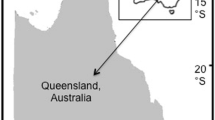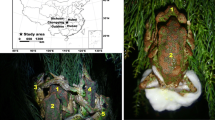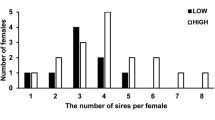Abstract
Male reproductive success (RS) in polygamous species with minimal social systems is often determined by the number of mates. However, because male RS is translated through females, the number of offspring sired can also be influenced by female qualities. Empirically sufficient data to document how tradeoffs between mate number and quality influence male RS are seldom available for long-lived, iteroparous species. We combined long-term life history data (1983–2006) on the E. S. George Reserve (ESGR, MI, USA) with parentage data from 155 clutches of 59 female painted turtles (Chrysemys picta marginata) of varying reproductive frequencies (2003–2006) to determine the relative contribution of female numbers and qualities on male RS. One previously documented trait of female painted turtles that can have substantial influences on male RS is repeat paternity through the use of stored sperm to fertilize over 95 % of within-year clutches. In addition, our study found that second-clutch producing female painted turtles on the ESGR have higher among-year reproductive frequencies than do first-clutch only females. Multiple paternity was detected in 14.1 % of clutches (min-max = 6.1–30.0 % annually), and the number of mates of both sexes was low annually (males 1.0; females 1.2) and over 4 years (males 1.1; females 1.7). Among successful males, RS varied substantially (1–32 offspring) and was strongly influenced by the combination of female reproductive frequency and repeat paternity (>38 % among years), but not mate number. Low mate number for both sexes was unexpected in a species without complex mating behaviors or parental care.




Similar content being viewed by others
References
Altmann J (1997) Mate choice and intrasexual reproductive competition: contributions to reproduction that go beyond acquiring more mates. In: Gowaty P (ed) Feminism and evolutionary biology: boundaries, intersections, and frontiers. Chapman Hall, New York, pp 320–333
Amundsen T (2000) Why are female birds ornamented? Trends Ecol Evol 15:149–155
Andersson M (1994) Sexual selection. Princeton University Press, Princeton
Bateman AJ (1948) Intra-sexual selection in Drosophila. Heredity 2:349–368
Birkhead TR, Møller AP (1993) Sexual selection and the temporal separation of reproductive events: sperm storage data from reptiles, birds and mammals. Biol J Linn Soc 50:295–311
Birkhead TR, Pizzari T (2002) Postcopulatory sexual selection. Nat Rev Genet 3:262–273
Blomqvist D, Wallander J, Andersson M (2001) Successive clutches and parental roles in waders: the importance of timing in multiple clutch systems. Biol J Linn Soc 74:549–555
Bonduriansky R (2001) The evolution of male mate choice in insects: a synthesis of ideas and evidence. Biol Rev 76:305–339
Calsbeek R, Bonneaud C (2008) Postcopulatory fertilization bias as a form of cryptic sexual selection. Evolution 62:1137–1148
Callow P (2008) The cost of reproduction—a physiological approach. Biol Rev 54:23–40
Clutton-Brock TH (1991) The evolution of parental care. Princeton University Press, Princeton
Clutton-Brock TH (2007) Sexual selection in males and females. Science 318:1882–1885
Clutton-Brock TH, Vincent AC (1991) Sexual selection and the potential reproductive rates of males and females. Nature 351:58–60
Congdon JD (1989) Proximate and evolutionary constraints on energy relations of reptiles. Physiol Zool 62:356–373
Congdon JD, Gibbons W (1987) Morphological constraint on egg size: a challenge to optimal egg size theory? Proc Natl Acad Sci U S A 84:4145–4147
Congdon JD, Gibbons JW (1996) Structure and dynamics of a turtle community over two decades. In: Cody ML, Smallwood JA (eds) Long-term studies of vertebrate communities. Academic Press, San Diego, pp 137–156
Congdon JD, Nagle RD, Kinney OM, van Loben Sels RC, Quinter T, Tinkle DW (2003) Testing hypotheses of aging in long-lived Painted turtles (Chrysemys picta). Exp Gerontol 38:765–772
Congdon JD, Pappas MJ, Brecke BJ (2011) Conservation implications of initial orientation of naive hatchling Snapping turtles (Chelydra serpentina) and Painted turtles (Chrysemys picta belli) dispersing from experimental nests. Chelonian Conserv Biol 10:42–53
Congdon JD, Tinkle DW (1982) Reproductive energetics of the Painted Turtle (Chrysemys picta). Herpetologica 38:228–237
Darwin C (1871) The descent of man and selection in relation to sex. Princeton University Press, Princeton
Dewsbury DA (1982) Ejaculate cost and male choice. Am Nat 119:601–610
Dreiss AN, Cote J, Richard M, Federici P, Clobert J (2010) Age- and sex-specific response to population density and sex ratio. Behav Ecol 21:356–364
Eberhard W (1996) Female control: sexual selection by cryptic female choice. Princeton University Press, Princeton
Eberhard W (2009) Postcopulatory sexual selection: Darwin’s omission and its consequences. Proc Natl Acad Sci U S A 106:10025–10032
Eisenberg JF (1981) The mammalian radiations. University of Chicago Press, Chicago
Emlen S, Oring L (1977) Ecology, sexual selection, and the evolution of mating systems. Science 197:215–223
Ernst C (1971) Population dynamics and activity cycles of Chrysemys picta in Southeastern Pennsylvania. J Herpetol 5:151–160
Ewing H (1943) Continued fertility in female box turtles following mating. Copeia 1943:112–114
Fiala KL, Congdon JD (1983) Energetic consequences of sexual size dimorphism in nestling Red-Winged Blackbirds. Ecology 64:642–647
Fitzsimmons NN (1998) Single paternity of clutches and sperm storage in the promiscuous green turtle (Chelonia mydas). Mol Ecol 7:575–584
Fiumera AC, Porter BA, Grossman GD, Avise JC (2002) Intensive genetic assessment of the mating system and reproductive success in a semi-closed population of the mottled sculpin, Cottus bairdi. Mol Ecol 11:2367–2377
Gibbons JW (1976) Aging phenomena in reptiles. In: Elias MF, Eleftheriou BE, Elias PK (eds) Experimental aging research. EAR Inc., Bay Harbor, pp 454–475
Gibbons JW (1982) Reproductive patterns in freshwater turtles. Herpetologica 38:222–227
Gibbons JW, Greene JL (1979) X-ray photography: a technique to determine reproductive patterns of freshwater turtles. Herpetologica 35:86–89
Gibbs HL, Weatherhead PJ, Boag PT, White BN, Tabak LM, Hoysak DJ (1990) Realized reproductive success of polygynous Red-Winged Blackbirds revealed by DNA markers. Science 250:1394–1397
Gist DH, Jones JM (1989) Sperm storage within the oviduct of turtles. J Morphol 199:379–384
Gist DH, Congdon JD (1998) Oviductal sperm storage as a reproductive tactic of turtles. J Exp Zool 282:526–534
Gist DH, Dawes SM, Turner TW (2002) Sperm storage in turtles: a male perspective. J Exp Zool 292:180–186
Gwynne DT (1981) Sexual difference theory: Mormon crickets show role reversal in mate choice. Science 213:779–780
Halliday TR (1983) The study of mate choice. Cambridge University Press, Cambridge
Hauber ME, Lacey EA (2005) Bateman’s principle in cooperatively breeding vertebrates: the effects of non-breeding alloparents on variability in female and male reproductive success. Integr Comp Biol 45:903–914
Heins DC, Rabito FG (1986) Spawing performance of North American minnows: direct evidence of the occurrence of multiple clutches in the genus Notropis. J Fish Biol 28:343–357
Hinton TG, Fledderman PD, Lovich JE, Congdon JD, Gibbons JW (1997) Radiographic determination of fecundity: is the technique safe for developing turtle embryos? Chelonian Conserv Biol 2:409–414
Inouye CY, Hill GE, Stradi RD, Montgomerie R, Bosque C (2001) Carotenoid pigments in male house finch plumage in relation to age, subspecies, and ornamental coloration. Auk 118:900–915
Iverson JB, Prosser RL, Dalton EN (2009) Orientation in juveniles of a semiaquatic turtle, Kinosternon Flavescens. Herpetologica 65:237–245
Jennions MD, Petrie M (2000) Why do females mate multiply? A review of the genetic benefits. Biol Rev 75:21–64
Jensen MP, Abreu-Grobois FA, Frydenberg J, Loeschcke V (2006) Microsatellites provide insight into contrasting mating patterns in arribada vs. non-arribada olive ridley sea turtle rookeries. Mol Ecol 15:2567–2575
Jeswiet SB, Lee-Jenkins SSY, Godin J-GJ (2012) Concurrent effects of sperm competition and female quality on male mate choice in the Trinidadian guppy (Poecilia reticulata). Behav Ecol 23:195–200
Jones AG (2005) Gerud 2.0: a computer program for the reconstruction of parental genotypes from half-sib progeny arrays with known or unknown parents. Mol Ecol Notes 5:708–711
Jones B, Grossman GD, Walsh DCI, Porter BA, Avise JC, Fiumera AC (2007) Estimating differential reproductive success from nests of related individuals, with application to a study of the mottled sculpin, Cottus bairdi. Genetics 176:2427–2439
Kalinowski S, Taper M, Marshall T (2007) Revising how the computer program CERVUS accommodates genotyping error increases success in paternity assignment. Mol Ecol 16:1099–1106
Lee PLM (2008) Molecular ecology of marine turtles: new approaches and future directions. J Exp Mar Biol Ecol 356:25–42
Le Roux E, Scholtz C, Kinahan A, Bateman P (2008) Pre- and post-copulatory mate selection mechanisms in an African Dung Beetle, Circellium bacchus (Coleoptera: Scarabaeidae). J Insect Behav 21:111–122
Libants S, Kamarainen AM, Scribner KT, Congdon JD (2004) Isolation and cross-species amplification of seven microsatellite loci from Emydoidea blandingii. Mol Ecol Notes 4:300–302
McGuire JM, Congdon JD, Scribner K, Capps J (2011) Variation in female reproductive quality and reproductive success of male Painted Turtles (Chrysemys picta marginata). Can J Zool 89:1136–1145
Morrison C, Hero J-M (2003) Geographic variation in life-history characteristics of amphibians: a review. J Anim Ecol 72:270–279
Osentoski MF, Mockford SM, Wright JM, Snyder M, Herman TB, Hughes CR (2002) Isolation and characterization of microsatellite loci from Blanding’s turtle, Emydoidea blandingii. Mol Ecol Notes 2:147–149
Owens IPF, Thompson DBA (1994) Sex differences, sex ratios and sex roles. Proc R Soc Lond B 258:93–99
Pappas MJ, Congdon JD, Brecke BJ, Capps JD (2009) Orientation and dispersal of hatchling Blanding’s turtles (Emydoidea blandingii) for experimental nests. Can J Zool 87:755–766
Pearse DE, Avise JC (2001) Turtle mating systems: behavior, sperm storage, and genetic paternity. J Hered 92:206–211
Pearse DE, Janzen FJ, Avise JC (2001) Genetic markers substantiate long-term storage and utilization of sperm by female painted turtles. Heredity 86:378–384
Pearse DE, Janzen F, Avise J (2002) Multiple paternity, sperm storage, and reproductive success of female and male painted turtles (Chrysemys picta) in nature. Behav Ecol Sociobiol 51:164–171
Phillips KP, Jorgensen TH, Jolliffe KG, Jolliffe S-M, Henwood J, Richardson DS (2013) Reconstructing paternal genotypes to infer patterns of sperm storage and sexual selection in the hawksbill turtle. Mol Ecol 22:2301–2312
R Core Development Team (2007) R: a language and environment for statistical computing. R Foundation for Statistical Computing, Vienna, Austria. URL http://www.R-project.org
Ribble DO (1992) Lifetime reproductive success and its correlates in the monogamous rodent, Peromyscus californicus. J Anim Ecol 61:457–468
Rittschof CC, Hilber SA, Tudor MS, St Mary CM (2012) Modeling male reproductive strategies and optimal mate number in an orb-web spider. Behav Ecol 23:1–10
Rodriguez-Munoz R, Bretman A, Slate J, Walling CA, Tregenza T (2010) Natural and sexual selection in a wild insect population. Science 328:1269–1272
Roques S, Díaz-Paniagua C, Portheault A, Pérez-Santigosa N, Hidalgo-Vila J (2006) Sperm storage and low incidence of multiple paternity in the European pond turtle, Emys orbicularis: a secure but costly strategy? Biol Conserv 129:236–243
Rowe S, Hutchings JA, Skajaeraasen JE (2007) Nonrandom mating in a broadcast spawner: mate size influences reproductive success in Atlantic cod (Gadus morhua). Can J Fish Aquat Sci 64:219–226
Salehialavi Y, Fritzsche K, Arnqvist G (2011) The cost of mating and mutual mate choice in 2 role-reversed honey locust beetles. Behav Ecol 22:1104–1113
Schielzeth H, Forstmeier W (2009) Conclusions beyond support: overconfident estimates in mixed models. Behav Ecol 20:416–420
Schubert M, Pillay N, Ribble DO, Schradin C (2009a) The Round-Eared Sengi and the evolution of social monogamy: factors that constrain males to live with a single female. Ethology 115:972–985
Schubert M, Schradin C, Rödel H, Pillay N, Ribble D (2009b) Male mate guarding in a socially monogamous mammal, the Round-Eared Sengi: on costs and trade-offs. Behav Ecol Sociobiol 64:257–264
Servedio MR, Lande R (2006) Population genetic models of male and mutual mate choice. Evolution 60:674–685
Shine R, Phillips B, Waye H, LeMaster M, Mason RT (2003) The lexicon of love: what cues cause size-assortative courtship by male garter snakes? Behav Ecol Sociobiol 53:234–237
Shuster S, Wade M (2003) Mating systems and strategies. Princeton University Press, Princeton
Stearns SC (1983) The influence of size and phylogeny on patterns of covariation among life-history traits in the mammals. Oikos 41:173–187
Taylor EH (1933) Observations on the courtship of turtles. Univ Kansas 21:269–271
Tinkle DW, Wilbur HM, Tilley SG (1970) Evolutionary strategies in lizard reproduction. Evolution 24:55–74
Trivers RL (1972) Parental investment and sexual selection. In: Campbell B (ed) Sexual selection and the descent of man 1871–1971. Aldine Transaction, Chicago, pp 136–179
Uller T, Olsson M (2008) Multiple paternity in reptiles: patterns and processes. Mol Ecol 17:2566–2580
Valenzuela N, Janzen F (2001) Nest-site philopatry and the evolution of temperature-dependent sex determination. Evol Ecol Res 3:779–794
Wang J (2004) Sibship reconstruction from genetic data with typing errors. Genetics 166:1963–1979
Weatherhead PJ, Robertson RJ (1977) Harem size, territory quality, and reproductive success in the redwinged blackbird (Agelaius phoeniceus). Can J Zool 55:1261–1267
Webster MS, Pruett-Jones S, Westneat DF, Arnold SJ (1995) Measuring the effects of pairing success, extra-pair copulations and mate quality on the opportunity for sexual selection. Evolution 49:1147–1157
Wilberg MJ, Dreher BP (2004) Genecap: a program for analysis of multilocus genotype data for non-invasive sampling and capture-recapture population estimation. Mol Ecol Notes 4:783–785
Wilbur HM, Morin PJ (1988) Life history evolution in turtles. In: Gans C, Huey RB (eds) Biology of the Reptilia, vol 16. Alan Liss, New York, pp 387–439
Zeh JA, Zeh DW (1997) The evolution of polyandry II: post-copulatory defences against genetic incompatibility. Proc R Soc Lond B 264:69–75
Zhang M, Li J, Zhu Y, Wang X, Wang S (2010) Male mate choice in Tibetan macaques Macaca thibetana at Mt. Huangshan, China. Curr Zool 56:213–221
Acknowledgments
We recognize the contributions of the long-term field crew H. Avery, O. Kinney, T. Quinter, and R. van Loben Sels and the large number of shorter term field assistants. Thanks to Ruth Estes and Margaret Burkman for long hours of line editing the mark-recapture, X-radiograph, and nesting ecology data sets, and special thanks to Cece Fabbro for her company, conversations, and emergency help processing hatchlings used in the genetics study. Assistance with the laboratory portion of the study was provided by S. Libants, K. Bennett, and J. Weatherhead, and B. Jones helped with obtaining and facilitating the use of the NEST program. Improvements of earlier drafts of the manuscript are the results of comments from N. Dickson, K. Holekamp, R. van Loben Sels, D. Schemske, A. McAdam, members of the Scribner lab, and V. Buonaccorsi and from reviews and comments from F. Janzen. The first third of the life history research study was supported by the National Science Foundation (DEB-74-070631, DEB-79-06301, BSR-84-00861, and BSR-90-19771) to JDC, and manuscript preparation was aided by the Environmental Remediation Sciences Division of the Office of Biological and Environmental Research, U.S. Department of Energy through the Financial Assistant Award no. DE-FC09-96SR18546 to the University of Georgia Research Foundation. Additional support for the life history and genetics study was provided by N. Dickson, J. Congdon, the Fabbro family, and M. Tinkle. Research and manuscript preparation were aided by the University of Michigan Museum of Zoology and Ecology and Evolutionary Biology Department (JMM), the Partnership for Ecosystem Research and Management (PERM) program between the Michigan Department of Natural Resources and Michigan State University Department of Fisheries and Wildlife (KTS), and the Michigan Agricultural Experimental Station (KTS).
Ethical standards
All research was conducted in accordance with the laws of the United States of America and the University of Michigan Animal Use and Care Committee (UCUCA #8496).
Author information
Authors and Affiliations
Corresponding author
Additional information
Communicated by T. Madsen
Rights and permissions
About this article
Cite this article
McGuire, J.M., Congdon, J.D., Scribner, K.T. et al. Female reproductive qualities affect male painted turtle (Chrysemys picta marginata) reproductive success. Behav Ecol Sociobiol 68, 1589–1602 (2014). https://doi.org/10.1007/s00265-014-1768-x
Received:
Revised:
Accepted:
Published:
Issue Date:
DOI: https://doi.org/10.1007/s00265-014-1768-x




